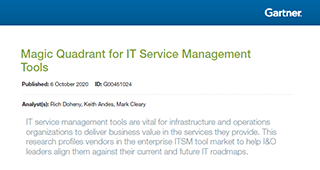In our earlier blog post on IT Support levels, we defined a typical IT support organization as being organized around the five support tiers listed in Table 1.
While Tier 0 through Tier 3 IT support builds on itself and provides an escalation and resolution process for troubleshooting and fulfilling service requests, Tier 4 is a different animal. Tier 4 support provides all the same services as Tiers 0-3, but it provides them outside an organization’s regular IT support structure. Tier 4 support is provided by outside vendors coordinated by internal personnel.
To understand the challenges and opportunities in providing Tier 4 support, let talk about the hardware and software maintenance resources needed for Tier 4 support. In future posts, we’ll look at other aspects of IT support that can affect your IT Service Management (ITSM) environment.
Tier 4 and maintenance support
Tier 4 support is powered by software and hardware maintenance contracts and statements of work (SOWs). Maintenance contracts and SOWs lay out the exact services and support provided, including what is supported, support hours, rates, legal obligations, and Service Level Agreements (SLAs). SOWs are used to purchase regular maintenance and troubleshooting services (break/fix), as well as contracting for project work when you want to install, configure, or upgrade new and existing services.
Tier 4 support requires your support organization to purchase and indefinitely maintain a number of support contracts for critical items, including:
- Operating system support
- Server maintenance
- Application support including programming and troubleshooting, for enterprise software, special purpose software, network software, and desktop software
- Network appliance configuration and maintenance for items such as routers, firewalls, switches, Web filtering hardware, etc.
- Copier maintenance
- PC maintenance
- Email systems
- Laser, bar-code, and high speed impact printers
- Scanners
- Cell phones
- Telecommunications lines
- UPS systems and generators
- Air conditioners
All of which adds up to a fair number of maintenance contracts and SOWs that need to be tracked for tier 4 support.
That means the first item of business when you add any new capability, equipment, or software to your network is to identify, set up, and document the following:
- Identify what type of support is needed, tier 0-3 (inside) or tier 4 (outside vendor)
- Determine who your tier 4 supporting organization will be for the item
- Negotiate and get a maintenance or SOW quote for the vendor’s services
- Determine what costs are necessary to deliver this service and what time period the contract covers
- Get approval and add the new expense into your budget. Since tier 4 support is an IT service rather than capital, it will probably be budgeted as an expense item.
- Determine how you will track and report on incidents or requests sent to an outside vendor. Service Management platforms such as BMC Remedy 9 provide incident tracking, problem management, change management, service request management, and a configuration management database (CMDB) that provide all the capabilities you need for tracking and reporting.
Tier 4 support requires a fair amount of contract management and repeatable budgeting events. Each support contract has its own documentation, payment due date, and contract expiration date. To confuse matters, you may have several support contracts with the same vendor, with each contract having different expiration dates. In a single vendor-multiple contract situation, it’s helpful to contact and arrange for all of their support services to be co-terminus, meaning they all expire at the same time each year.
Should you drop tier 4 support for a particular item?
You should think carefully before halting a support contract, particularly for expensive items. Hardware and software providers tend to price support at about 20-25% of the purchase price, such that every 4-5 years you wind up paying for the product a second time. Some shops are tempted to skip paying support for items that never change or for program maintenance that they believe they will never use.
But beware. Many software and hardware vendors have policies that if a customer lets support lapse, the customer has to pay yearly support all the way back to the time they stopped paying support…sometimes with penalties.
A good rule of thumb is to buy maintenance for any items that you either don’t want to or can’t maintain yourself or that are too expensive to replace. The worst feeling in the world is when you have to replace an expensive IT item or pay back maintenance because you didn’t keep up with the maintenance contract after the first year’s maintenance runs out.
For more information
If you’re interested in more information about IT support levels and tier 4 support, please feel free to contact us at BMC software. We provide several products dealing with IT service delivery, and we are experts in the field.
Table 1: Typical IT Support Tiers
| Support tier | Purpose |
|---|---|
| Tier 0 – Self-service and user-retrieved information | Provide users with self-service tools to solve problems themselves and to escalate requests to Tier 1, if needed. Generally Web or app-based support. |
| Tier 1 – Basic Help Desk resolution and Service Desk delivery | Support for basic customer issues that solve known problems and fulfill service requests |
| Tier 2 – In-depth technical support | Uses experienced and knowledgeable engineers to assess issues and provide solutions not available in tier 1 |
| Tier 3 – Expert product and service support | Highly skilled product specialists including product owners and creators find root causes for difficult problems and decide whether or not a new fix will be created |
| Tier 4 – Outside support for products not supported by the organization | Contracted support for items provided by the organization but not directly supported by the organization |





